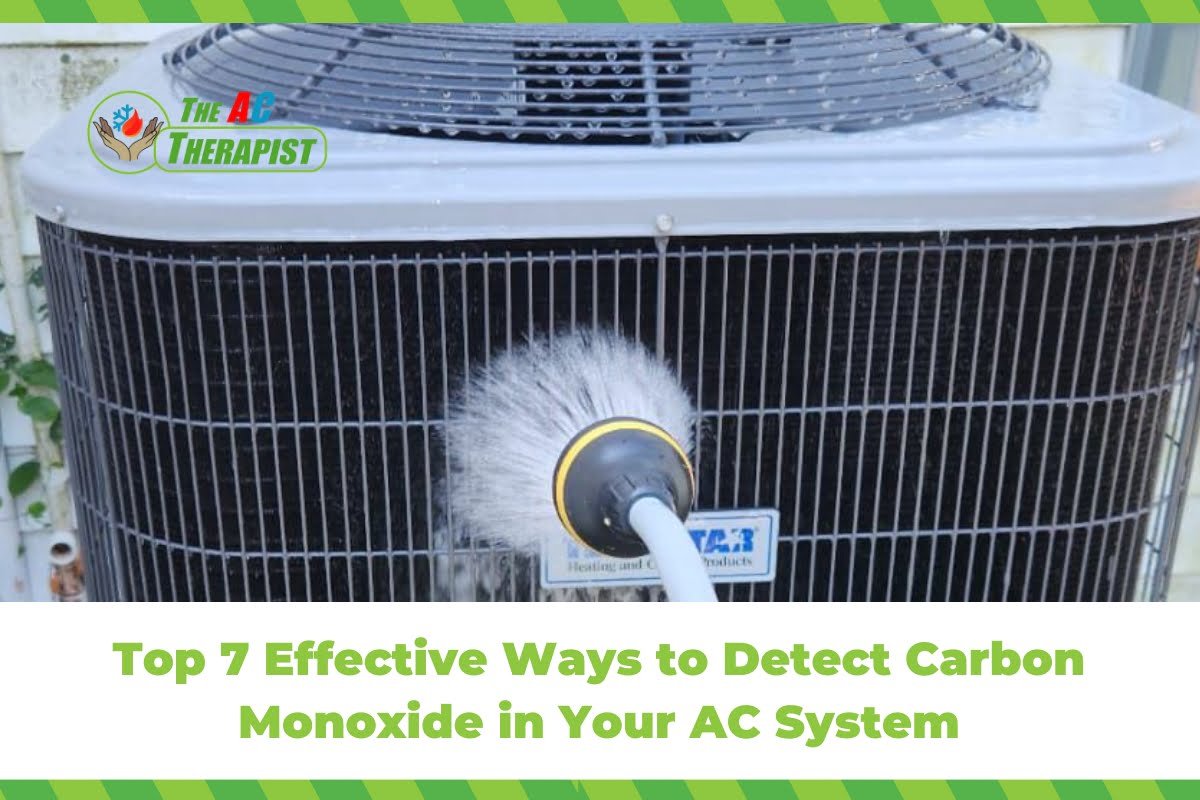Top 7 Effective Ways to Detect Carbon Monoxide in Your AC System
Carbon monoxide (CO) is a colorless, odorless gas that can be produced by malfunctioning or improperly maintained heating systems, including furnaces and boilers. While your expertise as The AC Therapist primarily focuses on air conditioning services, it’s important to note that CO concerns are related to heating systems rather than air conditioning. Ensuring proper maintenance of heating systems, including regular inspections and maintenance checks, is crucial to prevent the risk of carbon monoxide leaks. If your clients have concerns about carbon monoxide or heating system maintenance, it’s advisable to address these issues promptly and provide appropriate guidance to ensure their safety.
The serene comfort of your home depends on your air conditioning (AC) system, but its functionality extends beyond temperature control. Carbon monoxide (CO), an odorless and colorless gas, can infiltrate your living space if your AC system isn’t properly maintained. Safeguarding your home from this hidden danger requires a comprehensive understanding of how to detect carbon monoxide leaks. In this comprehensive guide, we’ll delve even deeper into the top 7 effective ways to identify and prevent CO leaks, empowering you with the knowledge to ensure a secure and serene living environment.
1. Install Carbon Monoxide Detectors: Early Alert System
Carbon monoxide detectors act as a sentinel, constantly monitoring your indoor air for dangerous levels of CO. Strategically placing these detectors in key areas, such as bedrooms and hallways, ensures that you’ll be promptly alerted if CO concentrations rise to hazardous levels.
2. Prioritize Regular AC System Inspections: Professional Oversight
While you may be vigilant about cleaning or changing air filters, the heart of your AC system requires professional attention. Annual inspections by HVAC experts delve into the intricate components of your system, catching potential issues before they escalate and lead to CO leaks.
3. Monitor Flame Color in Furnaces: Visual Clues
If your AC system relies on a furnace, become a flame watcher. A consistent blue flame indicates proper combustion, but a yellow or orange flame is a sign of incomplete combustion, which can produce CO. This visual cue is your indicator to seek professional help.
4. Thoroughly Check for Visible Rust or Corrosion: Visual and Structural Inspection
Deterioration in your AC system, especially in exhaust and ventilation components, can be a pathway for CO to enter your home. Regularly inspect these parts for signs of rust or corrosion, addressing any concerns promptly.
5. Recognize and Respond to Physical Symptoms: Personal Vigilance
Carbon monoxide poisoning often starts with vague symptoms like headaches, dizziness, or nausea. If these symptoms occur regularly, particularly when you’re at home, consider the possibility of CO exposure and take swift action.
6. Ensure Adequate Ventilation: The Importance of Airflow
Proper ventilation is a powerful defense. Blocked vents can cause CO to accumulate indoors. Regularly check and clean vents, ensuring that gases are effectively directed outside your living spaces.
7. Educate Yourself and Your Household: Knowledge is Safety
Educating your family about carbon monoxide risks and detection methods empowers everyone to respond effectively. Create an emergency plan that includes knowing how to evacuate, seeking medical attention, and contacting professionals.
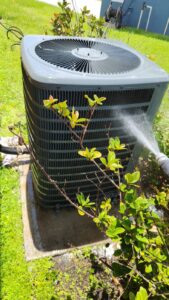
Do Air Conditioners Produce Carbon Monoxide?
No, air conditioners themselves do not produce carbon monoxide (CO). Air conditioners work by cooling and circulating air within your living space, but they do not involve combustion processes that could produce CO as a byproduct. CO is typically produced by fuel-burning appliances such as furnaces, water heaters, stoves, and generators that use natural gas, oil, wood, or other fuels.
However, it’s important to note that if your HVAC system includes a furnace, which is a heating component, and if that furnace is not properly maintained or has combustion issues, it could potentially produce carbon monoxide. In such cases, the issue would lie with the furnace rather than the air conditioning component of the HVAC system.
Regular maintenance and proper ventilation of all fuel-burning appliances are essential to prevent carbon monoxide leaks and ensure the safety of your home. If you have any concerns about carbon monoxide in your home, it’s recommended to have a professional inspection and install carbon monoxide detectors for early warning.
What causes carbon monoxide in HVAC?
Carbon monoxide (CO) in HVAC systems is typically a result of incomplete combustion of fuels in heating components rather than the cooling components of the system. Here are some factors that can cause carbon monoxide in HVAC systems:
- Malfunctioning Furnaces: Furnaces are common components of HVAC systems that generate heat by burning fuels such as natural gas, oil, or propane. If a furnace is malfunctioning, it may not burn the fuel completely, leading to the production of carbon monoxide.
- Poor Ventilation: Inadequate ventilation in the area where the furnace is located can lead to the accumulation of carbon monoxide. Proper ventilation is necessary to safely expel combustion byproducts outdoors.
- Cracked Heat Exchangers: A heat exchanger is a component in a furnace that separates the combustion process from the air being circulated through the system. If the heat exchanger is cracked or damaged, it can allow carbon monoxide to mix with the air that is being distributed throughout your home.
- Blocked Flues or Vents: Flues and vents are designed to carry combustion byproducts, including carbon monoxide, out of your home. If these flues or vents are blocked or obstructed, the gases may back up into your living space.
- Improperly Installed or Maintained Systems: HVAC systems need to be installed and maintained by qualified professionals. Improper installation or lack of maintenance can lead to combustion issues and carbon monoxide leaks.
- Old or Inefficient Equipment: Older HVAC equipment may have worn-out components that affect combustion efficiency. Upgrading to newer, more efficient equipment can reduce the risk of carbon monoxide leaks.
- Use of Unvented Appliances: Using unvented or improperly vented appliances that burn fuels indoors, such as gas stoves or unvented space heaters, can contribute to indoor carbon monoxide levels.
To prevent carbon monoxide issues in HVAC systems, regular professional maintenance and inspections are essential. Installing carbon monoxide detectors in your home can provide an added layer of safety, alerting you to elevated CO levels so you can take appropriate action. If you suspect a carbon monoxide leak or have concerns about the safety of your HVAC system, it’s crucial to seek assistance from qualified HVAC professionals.
What are two warning signs of carbon monoxide poisoning?
Carbon monoxide (CO) is a colorless, odorless gas that can be extremely dangerous and even fatal in high concentrations. Here are two warning signs of carbon monoxide poisoning to be aware of:
- Flu-like Symptoms: Carbon monoxide poisoning symptoms can resemble those of the flu, making it easy to overlook until it becomes severe. These symptoms can include headaches, dizziness, nausea, vomiting, weakness, confusion, and shortness of breath. Individuals exposed to CO may feel better when they are away from the source of exposure (e.g., home), which can make diagnosis challenging.
- Cherry-Red Skin or Lips: In more severe cases of carbon monoxide poisoning, a person’s skin or lips might take on a bright cherry-red color. However, this symptom is relatively rare and often occurs only when the levels of CO exposure are extremely high.
It’s important to note that these symptoms can vary depending on the level and duration of exposure to carbon monoxide. If you suspect carbon monoxide poisoning, you should take immediate action: leave the area with suspected CO exposure, get fresh air, and seek medical attention. If you have a carbon monoxide detector in your home, it may also sound an alarm if CO levels become dangerous. Regular maintenance of fuel-burning appliances, proper ventilation, and the use of carbon monoxide detectors can help prevent these risks.
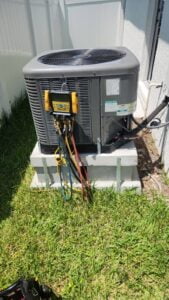
What does carbon monoxide smell like?
Imagine a gas leak or the smell of smoke—these odors are immediate alerts that something is wrong, prompting us to take action and evacuate the area. However, carbon monoxide doesn’t provide such a warning. It can seep into your living spaces silently, and you wouldn’t be able to smell it or see it. This makes it a “silent killer” because its effects can be devastating before you even realize it’s present.
The absence of a characteristic smell means that you cannot rely on your sense of smell to detect CO in your home. This is why carbon monoxide detectors are so crucial. These devices are specifically designed to sense the presence of CO in the air, even at low levels, and they emit a loud alarm to alert you to its presence. By relying on carbon monoxide detectors, you’re adding a layer of protection to your home and your family’s safety.
Understanding that carbon monoxide has no smell underscores the importance of proactive measures. Regular maintenance of fuel-burning appliances, proper ventilation, and the installation of carbon monoxide detectors are all vital steps to prevent exposure to this invisible threat. If you ever suspect a carbon monoxide leak, do not wait for a smell or other signs; take immediate action to ensure your safety and the safety of your loved ones. Leave the area, get to fresh air, and seek medical attention if symptoms of carbon monoxide poisoning are present. Remember, in the case of carbon monoxide, it’s better to be safe than sorry.
Steps to Prevent Carbon Monoxide Risks in Your Air Conditioning
Preventing carbon monoxide (CO) risks in your air conditioning system involves ensuring that your cooling system is well-maintained and that proper safety measures are in place. Although AC units themselves do not produce CO, they can indirectly contribute to CO buildup if certain conditions are not met. Here are steps you can take to prevent carbon monoxide risks in your air conditioning:
- Regular Maintenance: Schedule annual maintenance for your HVAC system, including the cooling and heating components. A well-maintained system is less likely to experience issues that could lead to CO production.
- Professional Inspection: Hire qualified HVAC technicians to inspect your air conditioning system, especially if it’s a split system that includes a furnace or other heating component. They can check for any potential combustion-related issues.
- Combustion System Checks: If your AC system includes a furnace or heating component, ensure that it’s properly inspected for combustion efficiency and that any necessary repairs or adjustments are made promptly.
- Proper Ventilation: Ensure that your HVAC system’s exhaust vents are unobstructed and effectively directing gases, including CO, outside your living spaces. Proper ventilation is crucial in preventing CO buildup.
- Carbon Monoxide Detectors: Even though AC units don’t produce CO, having carbon monoxide detectors installed in your home is essential. Place them near bedrooms and other key areas, as they can alert you to elevated CO levels from other sources.
- Appliance Ventilation: Make sure that any fuel-burning appliances (such as gas water heaters or stoves) in your home are properly vented to the outside to prevent CO buildup indoors.
- Educate Household Members: Teach your family about the risks of carbon monoxide and the importance of recognizing its symptoms. Make sure everyone knows what to do if a carbon monoxide detector goes off or if they experience symptoms.
- Regularly Check Appliances: Keep an eye on all fuel-burning appliances, not just your AC system. Check for any signs of malfunction, such as yellow or orange flames in gas appliances.
- Install Detectors Near AC Systems: While AC units themselves don’t produce CO, it’s still wise to have carbon monoxide detectors near your HVAC equipment to monitor for any unexpected leaks from other sources.
- Professional Installation: If you’re installing new HVAC equipment, rely on licensed professionals for installation to ensure everything is set up safely and correctly.
By following these steps, you can help ensure that your air conditioning system and overall indoor environment remain safe from carbon monoxide risks.
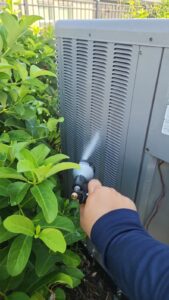
How AC Maintenance Prevents Carbon Monoxide Issues
AC maintenance plays a crucial role in preventing carbon monoxide (CO) issues, even though air conditioners themselves do not produce CO. The potential connection between AC maintenance and CO issues lies in the comprehensive care of your HVAC system, which may include components that can indirectly contribute to CO risks. Here’s how AC maintenance helps prevent CO issues:
- Overall System Health: AC maintenance involves a thorough inspection of your entire HVAC system, including any heating components like a furnace or heat pump. Ensuring these components are functioning correctly helps prevent combustion-related problems that could lead to CO production.
- Combustion Efficiency: If your AC system includes a furnace or heat pump, regular maintenance ensures that these heating components are burning fuel efficiently. Efficient combustion reduces the likelihood of incomplete combustion, which can produce CO.
- Ventilation Check: HVAC technicians inspect exhaust vents and ductwork during maintenance. Properly functioning vents and ducts ensure that gases, including CO, are correctly directed outside your living spaces.
- Early Detection: Regular maintenance catches issues early before they escalate. For instance, a cracked heat exchanger in a furnace can lead to CO leaks. Detecting such issues early prevents the potential for CO exposure.
- Cleaning and Airflow: Dirty or clogged components in your HVAC system can lead to inefficiencies and imbalances in combustion, which might result in CO production. Regular cleaning and maintenance ensure proper airflow and operation.
- Carbon Monoxide Detectors: Although AC units themselves don’t produce CO, a comprehensive maintenance checkup could include inspecting and testing carbon monoxide detectors in your home. These detectors can alert you to CO leaks from other sources.
- Peace of Mind: Knowing that your HVAC system has been thoroughly inspected and maintained provides peace of mind that your heating components are working safely, minimizing the risk of CO issues.
- Professional Expertise: HVAC technicians are trained to identify potential problems and provide solutions. Their expertise helps ensure that your system operates safely and efficiently.
- Educational Opportunities: During maintenance visits, HVAC professionals can educate homeowners about the risks of CO, how to recognize its symptoms, and what to do if there’s a concern.
- Preventative Measures: Maintenance often includes adjustments, lubrication, and cleaning that prevent issues from arising. Preventing issues from occurring in the first place is a key aspect of CO risk prevention.
In summary, while AC maintenance is primarily focused on cooling, it involves comprehensive system care that indirectly contributes to preventing CO issues. By ensuring that all components, including heating ones, are functioning optimally, you reduce the potential for combustion-related problems that could lead to CO production.
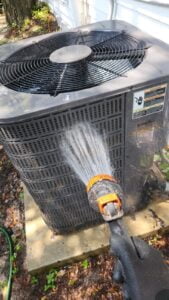
Empowered Vigilance: Safeguarding Your Haven from Carbon Monoxide Risks with The AC Therapist
As you strive to maintain a comfortable and safe home environment, the importance of vigilance cannot be overstated, especially when it comes to the unseen threat of carbon monoxide (CO). Your reliance on The AC Therapist for expert air conditioning (AC) solutions is a vital step towards a secure haven.
With the knowledge gained from the top 7 effective ways to detect carbon monoxide in your AC system, you are empowered to take proactive measures. Embrace the significance of carbon monoxide detectors, regular HVAC maintenance, and awareness of flame colors. The diligent checks for rust and corrosion, coupled with the recognition of telltale signs like flu-like symptoms or cherry-red skin, contribute to your family’s well-being.
To fortify your defense against CO risks, prioritize proper ventilation and educate your household on potential dangers. Moreover, consider taking immediate action by scheduling an AC maintenance appointment with The AC Therapist. Their commitment to your safety and comfort extends beyond mere cooling.
By synergizing The AC Therapist’s expertise with your determination to safeguard your loved ones, you’re creating a home that thrives on proactive care. Remember, your home is more than a space—it’s a sanctuary. With a solid foundation of knowledge and The AC Therapist’s support, you’re building a stronghold against carbon monoxide risks, ensuring your home remains the epitome of comfort and security. Don’t wait—schedule your AC maintenance today and fortify your defenses against CO risks.

